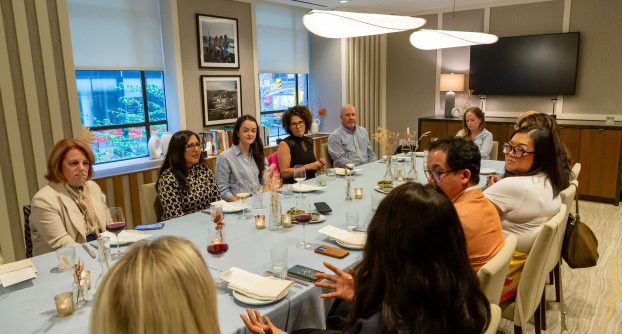It’s not every day that strategy sits down with a chief human resources officer.
Then again, it’s not everyday that businesses, from small firms to global brands, simultaneously implement sweeping work-from-home policies and focus their communications on the health, safety and financial well-being of their employees and customers.
As BMO’s head of HR, people and culture, Mona Malone has been deeply involved in all aspects of the bank’s response to the current health crisis, including areas that would typically fall outside of HR’s remit, such as consumer-facing initiatives. The chief of HR speaks on behalf of the bank’s COVID-19 efforts, revealing the intersection between a company’s purpose and brand and its efforts to protect and support its employees.
BMO is among the financial institutions that have lowered credit card interest rates, deferred mortgage payments, and offered lines of credit and capital to small- and medium-sized businesses since the health crisis began to unfold. With the goal of supporting people outside its customer base, the 203-year-old bank has donated a million dollars to the United Way, committed to supporting Kids Help Phone, and championed volunteerism within its workforce.
These, Malone says, are all examples of initiatives that address pressing issues but fundamentally align with the company’s purpose.
How do BMO’s consumer- and employee-facing initiatives ultimately tie back to your brand or purpose as a company?
Our purpose is to “grow the good in business and life.” When we developed our purpose, we never anticipated that it would guide us through such a large-scale pandemic. But it has absolutely been a lens on all of the decisions that we’ve made. For example, helping employees that need to get to work by putting in place a $50 per day stipend incentive. For many of those people, that’s a 30% lift in compensation given their hourly wage. The idea is helping people, knowing that there was a lot of stress and anxiety with respect to their financial situation.
Focusing on our health practices and safety practices in the work location, installing plexiglass between the teller and the customers, putting social distancing measures in place and closing branches and putting reduced hours in place – in the U.S., we only have our drive-up branches being used right now. All of those were actions taken to protect the health and safety of our employees while still providing customers with basic access [to our services] and ensuring that we could deliver the hardship programs that are still very important to our customers.
BMO has implemented work-from-home measures and is encouraging customers to bank digitally when possible. What impact will that have on your business once the pandemic is under control?
The pace of digital adoption due to necessity that has [occurred over] the last month [is incredible], whether it’s food ordering or digital banking. Our focus around making sure that we can digitize all of our processes is critical, because for those employees that are currently working from a worksite, if we digitize and enable them to work from home, that provides even more flexibility. So a huge focus area is end-to-end digitization, as well as continuing to educate customers and improve the digital offering for all of our customers.
I also think alternate architecture and work spaces have been a real topic of interest for the last four or five years. As we come out on the other side of COVID-19, it will cause us to revisit what the future workplace looks like. You’re going to see a change to less densification, and I think this will drive people to enjoy the flexibility that comes from working from home. Because of the investments in technology to make [working from home a] significant and good experience for employees, you’ll see a lot of employers adapting more quickly in terms of alternate work arrangements.
How are you managing a higher-than-normal volume of customer inquiries, and what are those customers most concerned about at the moment?
We’ve been leveraging our employees in branches, as well as the contact centre that are receiving and making outbound calls. The wait times have been longer, but the conversations have also been longer with customers, because many times they want to discuss the hardship programs that are put in place in terms of decreased rates for credit cards, deferring mortgage payments, how they’re going to manage cash flow issues.
Early on, with trips being cancelled, there were a lot of questions around travel insurance. That’s now pivoted more to hardship programs, and how people can manage their cash-flow situation in the weeks and months ahead. And for businesses, it’s about how they can manage their liquidity, cash flow, or restructuring. The advice and counsel that we can provide, whether it’s to an individual customer or a corporate customer, is really important to help them see through these very challenging times.
What do you believe will be the most significant impact of COVID-19 on the consumer mindset or on the way business is conducted in Canada?
It will absolutely transform the nature of digital services. The uptick that we’ll see around digital services across a whole variety of industries will be huge. I think corporate real estate strategy will be revisited. And through any large crisis, whether it’s wars, pandemics or recessions, there’s opportunity for acquisition and divestiture of businesses, so [we can expect] consolidation across different industries.
On a more personal level, when I think about what it means for individuals, many of our employees have shared that it’s caused them to have family dinners every night, or go for a walk and take pleasure in really small things. It shows the resilience of people and people coming together. That is a wonderful point of humanity. There’s also an enormous amount of collaboration happening between not-for-profit, public sector and government. That is extremely beneficial. When you look at the support the government is providing to Kids Help Phone, or the support companies will receive, those are great examples of the collaboration that happens across sectors and that’s important in a situation like this.
This interview is part of a series for Strategy C-Suite, a weekly email briefing on how Canada’s brand leaders are responding to market challenges and acting on new opportunities. Sign-up for the newsletter here to receive the latest stories directly to your inbox every Tuesday.
The interview has been edited for length and clarity.

























